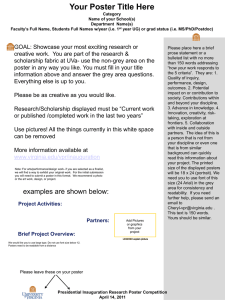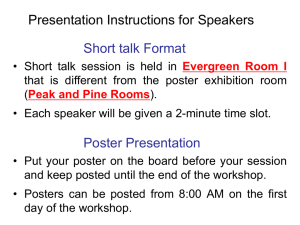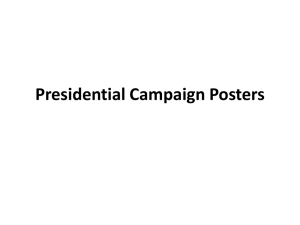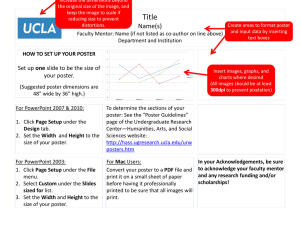Poster + Peer Assessment GG2509: Environment and Society
advertisement
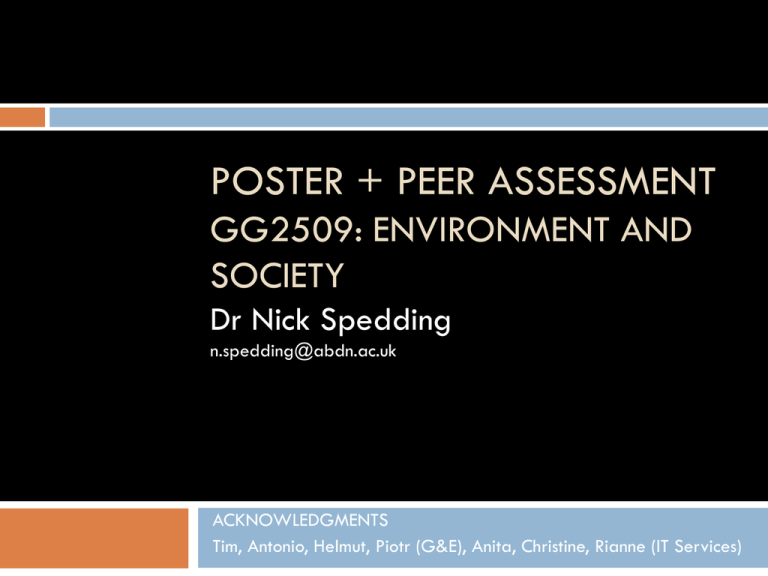
POSTER + PEER ASSESSMENT GG2509: ENVIRONMENT AND SOCIETY Dr Nick Spedding n.spedding@abdn.ac.uk ACKNOWLEDGMENTS Tim, Antonio, Helmut, Piotr (G&E), Anita, Christine, Rianne (IT Services) Course revamp Staff changes CREF revalidation + in-house review Concepts + case studies 6CC wish list... Inter-disciplinary No pre-reqs Non-traditional delivery + assessment 100% coursework (3 assignments) Why group work? Cuts down marking! 75% Collaborative skills Why posters? Something different Supports concepts + case studies approach Communications skills (GAs) Creative Social FUN? Why peer assessment? Curiosity + scepticism... Promote engagement + reflection (GAs) Generate more feedback Appropriate to poster format – audience reception Address subjectivity 8-10 people contribute to overall mark What did we need to do? Write a task brief Lecture slots to introduce this + suggest ideas Organise groups + allocate staff mentors Training for poster design New mark criteria New peer assessment form Publish posters on MyAberdeen + put on wall Mark the posters (staff + students) Collate + distribute feedback Task brief Posters must: Clearly identify an appropriate issue relevant to the course and address this using a suitable case study or selection of examples; Draw on at least one of the conceptual frameworks we have covered in lectures; Elucidate appropriate aspects of controversy / debate; Be clear and attractive in their use of text, images and colour, with clear layout/flow. Assessment breakdown 40% 50% 10% Staff mark using standard Level 2 descriptors – CONTENT Student peer assessment mark – DESIGN Staff mark using peer criteria (check) Level 2 descriptors: content 20, 19, 18 – Outstanding Direct, comprehensive answer to the question set, using a wide range of examples, evidence and arguments. Demonstrates a command of relevant facts and key concepts from the course. Excellent use of lecture and textbook material, supplemented by confident, effective use of additional sources; perhaps some use of research literature; shows clear ability to develop reasoned, sustained arguments. Discursive throughout, with clear evidence of critical ability. Fluent writing and structure, with high quality presentation throughout. 17, 16, 15 – Very Good Direct answer to the question set, using a range of information: solid factual basis supported by firm understanding of key concepts. Confident, effective use of lecture and textbook material, supplemented by some use of additional sources (for example, from newspapers, periodicals, judicious use of the internet, more specialist books) to develop reasoned arguments. Discursive rather than descriptive, with some evidence of critical ability. Fluent writing and structure, with high quality presentation throughout. 14, 13, 12 – Good Direct but narrow answer to the question set, with competent use of basic lecture and set textbook information. Sound factual base, with satisfactory understanding of key concepts from the course, but limited grasp of wider issues related to the question set. Descriptive rather than discursive, with limited evidence of ability to develop reasoned arguments. Limited evidence of reading beyond basic textbook material. Satisfactory organisation and presentation.. 11, 10, 9 – Pass Acceptable but inconsistent answer. Attempts to answer the question set, but lacks focus, with some content of limited relevance and/or poor organisation of material. Limited demonstration of knowledge and understanding; sketchy use of lecture material; perhaps some mistakes. Reliance on facts rather than argument, with little or no evidence of reading in support of work. Poor quality presentation. Criteria for peer assessment Academic standard. Is the poster topic/case study focused and coherent? Is it relevant to the wider theme of ‘environment and society’? How well does the poster use appropriate concepts to frame its argument? How effective is the use of evidence to support arguments? Originality of content. How much of this have you seen before? Did you learn something today? Does the poster add clear value to what we said in the lectures or what is readily available in textbooks? Does this poster add to what we might think of as popular stereotypes or general knowledge? Clarity of text. Can you read the text comfortably at a reasonable distance? Is the choice of font(s), its size, the use of bold or italics effective? What about the line spacing or the contrast between the text and the background? Use of graphics. How well does the poster make use of pictures, charts or tables to impart information, add variety and enhance its appeal? Layout. Does the poster appear balanced? Can you follow the flow of the argument easily? Are text boxes and graphics placed and spaced effectively? What about the use of colour, or any features such as bullet points or arrows to improve the presentation? Overall impact/appeal. Does the poster work for you? Is effective use made of the poster format? Or is this just an essay printed out big on a single sheet? Has this got the ‘wow’ factor? Peer form What I liked most about this poster was... To improve this poster I suggest... What did we get? See examples… Click on this link to view full size poster Click on this link to view full size poster Click on this link to view full size poster Click on this link to view full size poster If you have difficulty viewing the posters, go to http://www.abdn.ac.uk/cad/events-workshops/tfs/tfevent2013/teachingfellows-event-2013-ns/ Evaluation Enjoyable social experience for students and staff Impressive submissions Rapid + enjoyable marking Lots of feedback, quickly Detailed + constructive – from staff and students SCEFs 100% coursework popular! How helpful... ? ~80% approval (Totally or 4) for balance of assessment, explanation of assessment criteria ~70% approval (Totally or 4) for feedback It covered a wide variety of topics and issues which different lectureres (sic) brought different aspects and angles to light. The fact it didn't have an exam at the end - plus the assessments were very different and required the use of individual and group, computer and literature analysis skills. This gives the course a greater appeal in my opinion. Feedback of assessments was generally very helpful and detailed. Concerns #1 Complaints about group work? “group poster work, its hard to get everyone together at the same time, not everyone pulls their weight” Complaints about group marks? Complaints about peer marking? Concerns #2 Over-generous peer marking inflates final grade? Mean staff CAS = 15.39; mean peer mark = 14.09 Student + staff peer marks Students Staff 2012 14.09 14.09 Mean staff CAS 2012 = 15.39 Mean staff CAS 2013 = 14.88 Peer marks do not inflate grades! 2013 14.41 13.53 Conclusions Not especially innovative or original... Expedient Efficient Effective Enjoyable



